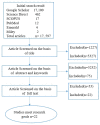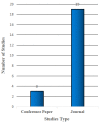IoT Adoption and Application for Smart Healthcare: A Systematic Review
- PMID: 35891056
- PMCID: PMC9316993
- DOI: 10.3390/s22145377
IoT Adoption and Application for Smart Healthcare: A Systematic Review
Abstract
In general, the adoption of IoT applications among end users in healthcare is very low. Healthcare professionals present major challenges to the successful implementation of IoT for providing healthcare services. Many studies have offered important insights into IoT adoption in healthcare. Nevertheless, there is still a need to thoroughly review the effective factors of IoT adoption in a systematic manner. The purpose of this study is to accumulate existing knowledge about the factors that influence medical professionals to adopt IoT applications in the healthcare sector. This study reviews, compiles, analyzes, and systematically synthesizes the relevant data. This review employs both automatic and manual search methods to collect relevant studies from 2015 to 2021. A systematic search of the articles was carried out on nine major scientific databases: Google Scholar, Science Direct, Emerald, Wiley, PubMed, Springer, MDPI, IEEE, and Scopus. A total of 22 articles were selected as per the inclusion criteria. The findings show that TAM, TPB, TRA, and UTAUT theories are the most widely used adoption theories in these studies. Furthermore, the main perceived adoption factors of IoT applications in healthcare at the individual level are: social influence, attitude, and personal inattentiveness. The IoT adoption factors at the technology level are perceived usefulness, perceived ease of use, performance expectancy, and effort expectations. In addition, the main factor at the security level is perceived privacy risk. Furthermore, at the health level, the main factors are perceived severity and perceived health risk, respectively. Moreover, financial cost, and facilitating conditions are considered as the main factors at the environmental level. Physicians, patients, and health workers were among the participants who were involved in the included publications. Various types of IoT applications in existing studies are as follows: a wearable device, monitoring devices, rehabilitation devices, telehealth, behavior modification, smart city, and smart home. Most of the studies about IoT adoption were conducted in France and Pakistan in the year 2020. This systematic review identifies the essential factors that enable an understanding of the barriers and possibilities for healthcare providers to implement IoT applications. Finally, the expected influence of COVID-19 on IoT adoption in healthcare was evaluated in this study.
Keywords: Internet of Things in healthcare; IoMT; IoT; IoT adoption; adoption factors; adoption theories; deep learning (DL); machine learning (ML); systematic review.
Conflict of interest statement
The authors declare no conflict of interest.
Figures












References
-
- Chiuchisan I., Costin H.N., Geman O. Adopting the internet of things technologies in health care systems; Proceedings of the 2014 International Conference and Exposition on Electrical and Power Engineering (EPE); Iasi, Romania. 16–18 October 2014; pp. 532–535. - DOI
-
- Mani V., Manickam P., Alotaibi Y., Alghamdi S., Khalaf O.I. Hyperledger Healthchain: Patient-Centric IPFS-Based Storage of Health Records. Electronics. 2021;10:3003. doi: 10.3390/electronics10233003. - DOI
-
- Keikhosrokiani P., Mustaffa N., Zakaria N. Success factors in developing iHeart as a patient-centric healthcare system: A multi-group analysis. Telemat. Inform. 2018;35:753–775. doi: 10.1016/j.tele.2017.11.006. - DOI
-
- Ejaz W., Anpalagan A. Internet of Things for Smart Cities: Technologies, Big Data and Security. Springer; Cham, Switzerland: 2019. - DOI
-
- Xu D.L., He W., Li S. Internet of things in industries: A survey. IEEE Trans. Ind. Inform. 2014;10:2233–2243. doi: 10.1109/TII.2014.2300753. - DOI
Publication types
MeSH terms
LinkOut - more resources
Full Text Sources
Medical

